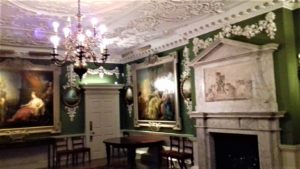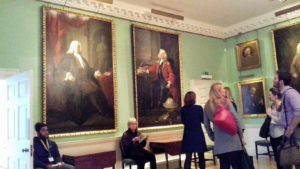The Museum of the Foundling Hospital, London is a little known gem. If you’re in London, do go and seek it out, it is very definitely worth a visit.
 Established by Captain Thomas Coram in 1739, with a lot of help from artists and musicians of the day, the Foundling Hospital lay in what is now called Coram’s Fields, just north of Lamb’s Conduit Street. It took Coram, a philanthropic sea captain, seventeen years of campaigning before he obtained a royal charter from George II and set up the hospital for abandoned children. The first stone of the Hospital was laid in 1742, although charitable work had begun before, the first child being taken in a year earlier.
Established by Captain Thomas Coram in 1739, with a lot of help from artists and musicians of the day, the Foundling Hospital lay in what is now called Coram’s Fields, just north of Lamb’s Conduit Street. It took Coram, a philanthropic sea captain, seventeen years of campaigning before he obtained a royal charter from George II and set up the hospital for abandoned children. The first stone of the Hospital was laid in 1742, although charitable work had begun before, the first child being taken in a year earlier.
One of the founding Governors was William Hogarth, artist and satirist, who designed the Hospital’s coat of arms and the uniforms worn by the children. Childless, he decided to set up a permanent art exhibition in the new Hospital building and he  encouraged his fellow artists, Reynolds, Hayman and Wilson to exhibit there. Soon everyone who was anyone wanted to look at the paintings in what was becoming Britain’s first public art gallery and members of la belle monde made contributions to the Hospital while they were there. The exhibitions were organised by the Dilettante Society, which eventually lead to the formation of the Royal Academy (see Varnishing Day). You can see Hogarth’s March of the Guards to Finchley on the ground floor where you can also find pieces by Grayson Perry and Emma Middleton and, outside, a Tracy Emin, which is a beautiful evocation of childhood. I won’t tell you where it is, ask a curator or volunteer. Thus the connection between art and the Hospital, or Coram, the modern version of the children’s charity, continues today.
encouraged his fellow artists, Reynolds, Hayman and Wilson to exhibit there. Soon everyone who was anyone wanted to look at the paintings in what was becoming Britain’s first public art gallery and members of la belle monde made contributions to the Hospital while they were there. The exhibitions were organised by the Dilettante Society, which eventually lead to the formation of the Royal Academy (see Varnishing Day). You can see Hogarth’s March of the Guards to Finchley on the ground floor where you can also find pieces by Grayson Perry and Emma Middleton and, outside, a Tracy Emin, which is a beautiful evocation of childhood. I won’t tell you where it is, ask a curator or volunteer. Thus the connection between art and the Hospital, or Coram, the modern version of the children’s charity, continues today.
 Hogarth’s portrait of Coram hangs in the museum, in one of the first floor rooms which replicate the old gallery rooms of the original hospital. When we visited, this lovely room was made even more enchanting by the baroque music of a cellist and pianist, practising for a formal performance later that day (the chairs for the audience were being brought up from the basement). It is music which is the other element in this story, specifically Handel’s Foundling Hospital Anthem and its Hallelujah Chorus, taken from his recently composed oratorio The Messiah. The benefit concert arranged and conducted by Handel led to him being elected a Governor and thereafter he conducted a performance of The Messiah annually in the
Hogarth’s portrait of Coram hangs in the museum, in one of the first floor rooms which replicate the old gallery rooms of the original hospital. When we visited, this lovely room was made even more enchanting by the baroque music of a cellist and pianist, practising for a formal performance later that day (the chairs for the audience were being brought up from the basement). It is music which is the other element in this story, specifically Handel’s Foundling Hospital Anthem and its Hallelujah Chorus, taken from his recently composed oratorio The Messiah. The benefit concert arranged and conducted by Handel led to him being elected a Governor and thereafter he conducted a performance of The Messiah annually in the  Hospital to raise funds. When he died he bequeathed a full score to the Hospital so that the concerts could continue, which they still do.
Hospital to raise funds. When he died he bequeathed a full score to the Hospital so that the concerts could continue, which they still do.
On the second floor the Handel Gallery houses an internationally important collection of manuscripts and artworks associated with Handle and his contemporaries. This visitor discovered that the high-backed winged armchairs were ‘listening’ chairs, each covering one type of music associated with Handel, opera, oratorios etc.. The track buttons were in the arms and the speakers in the chair wings. Ariodante, Julius Caesar, Music for the Royal Fireworks, I could have sat there all day.
The Hospital also has its links with literature, Dickens’ Mr Brownlow, saviour of Oliver in Oliver Twist was modelled on John Brownlow, Director of the Hospital in Dicken’s time. He stands centre stage in The Foundling Restored to its Mother (1858) by the artist Emma Brownlow, his daughter, in the Museum.
The Foundling Museum is open 6 days a week (closed Mondays) and it costs £11 to enter, £8.50 concessions, which also gives access to temporary exhibitions on the lower ground floor (see web-site). The nearest tube is Russell Square (Piccadilly line) but it isn’t sign posted from there, take a map with you, it’s not easy to find.
I leave you with a filmed snippet. The gentleman to the right of the frame is making a sketch of the famous bust of Handel while the two women rehearse. Music and art in action in a place where music and art came together to rescue children.
If you enjoyed reading this post you might also enjoy Undiscovered Visit to Lord Leighton’s House Visit to Hertford House The Queen’s House


 RSS – Posts
RSS – Posts